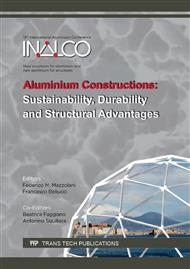[1]
E. Kandare et al., Creep-based life prediction modelling of aluminium in fire. Mat. Science Eng. A. 527 (2010) 1185-1193.
DOI: 10.1016/j.msea.2009.10.010
Google Scholar
[2]
J. Maljaars, F. Soetens, L. Katgerman, Constitutive model for aluminum alloys exposed to fire conditions. Metall. Mat. Trans. A. 39A (2008) 778-789.
DOI: 10.1007/s11661-008-9470-0
Google Scholar
[3]
EN 1999-1-1+A1 Eurocode 9: Design of aluminium structures – Part 1. 1: General rules and rules for buildings, CEN, Brussels, (2011).
DOI: 10.3403/02163035
Google Scholar
[4]
Aluminium Design Manual, Aluminium Association, Metals Park, (2015).
Google Scholar
[5]
EN 1999-1-2 Eurocode 9: Design of aluminium structures – Part 1. 2: Rules for fire design, CEN, Brussels, (2007).
Google Scholar
[6]
P. Zoetemeijer, A design method for the tension side of statically loaded, bolted beam-to-column connections. Heron 20 (1974) 1-59.
Google Scholar
[7]
H. Agerskov, High-strength bolted connections subjected to prying. J. Struct. Div. ASCE. 102 (1976) 161-175.
DOI: 10.1061/jsdeag.0004253
Google Scholar
[8]
A.J. Swanson, T.R. Leon, Bolted steel connections: tests on T-stub components. J. Struct. Eng. 126 (2000) 50-56.
DOI: 10.1061/(asce)0733-9445(2000)126:1(50)
Google Scholar
[9]
S. Spyrou, J.B. Davison, I.W. Burgess, R.J. and Plank, Experimental and analytical investigation of the tension zone, components within a steel joint at elevated temperatures. J. Constr. Steel Res. 60 (2004) 867-986.
DOI: 10.1016/j.jcsr.2003.10.006
Google Scholar
[10]
P. Barata et al., Assessment of the T-stub joint component at ambient and elevated temperatures. Fire Saf. J. 70 (2014) 1-13.
DOI: 10.1016/j.firesaf.2014.08.009
Google Scholar
[11]
S. Lin, Z. Huanga, M. Fan. Steel and Comp. Struct. 15 (2013) 81-101.
Google Scholar
[12]
F.M. Block et al., Principles of a component-based connection element for the analysis of steel frames in fire. Eng. Struct. 49 (2013) 1059-1067.
DOI: 10.1016/j.engstruct.2012.07.025
Google Scholar
[13]
L. Chen, Y.C. Wang, Efficient modelling of large deflection behaviour of restrained steel structures with realistic endplate beam/column connections in fire. Eng. Struct. 43 (2012) 194-209.
DOI: 10.1016/j.engstruct.2012.05.030
Google Scholar
[14]
K.S. Al-Jabri, Modelling and simulation of beam-to-column joints at elevated temperature: A review. J. Franklin Inst. 348 (2011) 1695-1716.
DOI: 10.1016/j.jfranklin.2010.09.002
Google Scholar
[15]
G. De Matteis, A. Mandara, F.M. Mazzolani, T-stub Aluminium Joints: the Influence of Behavioural Parameters. Comp. Struct. 78 (2000) 311-327.
DOI: 10.1016/s0045-7949(00)00081-x
Google Scholar
[16]
G. De Matteis et al., Behaviour of welded aluminium T-stub joints under monotonic loading Comp. Struct. 87 (2009) 990-1002.
DOI: 10.1016/j.compstruc.2008.04.022
Google Scholar
[17]
G. De Matteis, M.T. Naqash, G. Brando, Effective length of aluminium T-stub connections by parametric analysis. Eng. Struct. 41 (2012) 548-561.
DOI: 10.1016/j.engstruct.2012.03.052
Google Scholar
[18]
H. Xu, X. Guo, Y. Luo, The load-bearing capacity of aluminum alloy T-stub joints. Adv. Mat. Res. 261-263 (2011) 765-769.
DOI: 10.4028/www.scientific.net/amr.261-263.765
Google Scholar
[19]
E. Efthimiou, M. Zygomalas, C.C. Baniotopoulos, On the structural response of aluminium T-stub joints under tension. Trans. Famena 30 (2006) 45-58.
Google Scholar
[20]
J. Maljaars, Stress-strain curves of steel and aluminium exposed to natural fires. In: proc. 6th SIF, Michigan, DEStech Publications (2010) 890-899.
Google Scholar
[21]
F. Soetens, Welded connections in aluminium alloy structures, Heron 32 (1987) 1-22.
Google Scholar
[22]
J. Maljaars et al., Aluminium structures exposed to fire conditions – an overview, Heron 55 (2010) 85-122.
Google Scholar
[23]
R.B. Kirby. The behaviour of high-strength grade 8. 8 bolts in fire. J. Constr. Steel Res. 33 (1995) 3-38.
Google Scholar
[24]
Y. Sakumoto et al., Tests of Fire‐Resistant Bolts and Joints. J. Struct. Eng. 119 (1993) 3131-3150.
DOI: 10.1061/(asce)0733-9445(1993)119:11(3131)
Google Scholar
[25]
L. Gardner, N.R. Baddoo, Fire testing and design of stainless steel structures. J. Constr. Steel Res. 62 (2006) 532-543.
DOI: 10.1016/j.jcsr.2005.09.009
Google Scholar
[26]
J. Maljaars, L. Twilt, F. Soetens, Flexural buckling of fire exposed aluminium columns. Fire Saf. J. 44 (2009) 711-717.
DOI: 10.1016/j.firesaf.2009.02.002
Google Scholar


